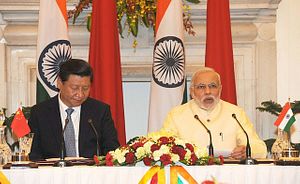Indian Prime Minister Narendra Modi concluded his speech at the 18th SAARC Summit in Kathmandu saying that India’s vision of the South Asia rests on five pillars: trade, investment, assistance, cooperation and people-to-people connections. Progress within the five pillars can only be achieved by focusing on “all through seamless connectivity.” India, being the biggest country in the regional bloc, explicitly highlighted that it would lead the sub-continent to shared peace and prosperity.
Since the inception of the South Asian Association for Regional Cooperation in 1985, India has been a leader, in which capacity it has delivered very little. Modi has been unable to change that: Pakistani Prime Minister Nawaz Sharif blocked all three key connectivity agreements, including the motor vehicle pact, which was proposed by India. Worse, at least from the perspective of the Modi government, might be the increased pressure from other member states to upgrade China’s role in SAARC. Led by Pakistan, China’s closest friend within the bloc, the summit saw intense lobbying to change China’s status from an observer to a member. Nepali politicians also called for China to be made a member. Interestingly, Nepal had also proposed to involve China as an observer state on the 2005 Dhaka summit.
While the Chinese government remained silent on the possibility of a full Chinese membership, the idea of a “SAARC+1” had in fact been floated at the 17th SAARC summit in Bhutan, emerging as a major concern for India. Almost all other small members of the SAARC have been hinting that the SAARC+1 should be materialized in order to have the deep pocketed China in the forum. Unfortunately for New Delhi, Chinese leaders Xi Jinping and Li Keqiang visited 26 countries within the 70 days prior to the summit, demonstrating again the strength of China’s investment appeal, for instance in the Pacific Islands and Fiji. More significantly, China’s Deputy Foreign Minister Liu Zhenmin announced in Kathmandu that “China has put forward a series of initiatives, including increasing trade between South Asia and China to 150 billion U.S. dollars and investment to 30 billion U.S. dollars in the next five years.” Indeed, the five pillars of the Indian vision for South Asia resemble China’s goals for the South Asian region. Apart from possessing more financial power, China’s crucial advantages over India are its huge experience and efficiency in economic areas like infrastructure construction, trade and investment.
However, the deep-rooted Indian political sentiment that wants to keep China out of the region is unrealistic. Chinese money is imperative to materialize Modi’s formula of five pillars for peace and prosperity on the sub-continent. Bilateral and multilateral agreements to enhance trade and investment flows in the region have been stymied by the procrastination of the giant Indian bureaucracy procrastinates. No significant progress has been made on the South Asia Free Trade Agreement (SAFTA) that came into force in 2006, mainly because India is very reluctant to reduce the list of sensitive goods. Meanwhile, China looks as if it might be using disagreements among the member states to boost its future influence. Could it have even blocked India’s proposals via Pakistan? It is hardly far-fetched to think it could have. China changed its status in the Arctic council in 2013 from ad hoc observer to permanent observer by using its influence over Iceland and Denmark. It also used its relationship with Cambodia at the ASEAN Summit in 2012 to avoid any condemnation over its assertiveness in the South China Sea.
India has to realize that having China in the forum will not harm India or the region, if India, China, and the other member states can build trust and jointly create prosperity for South Asia. Modi emphasized that “Infrastructure is our region’s greatest weakness and it’s most pressing need.” Given that, the whole region can win with Chinese investment and experience. Additional cooperation with China is also possible in the fight against terrorism and in responding to natural disasters. That, however, will require overcoming Indian sentiment on China when it comes South Asia.
“India has to lead and we will do our part,” Modi told the audience at the opening session of the summit. This statement shows that India does not like to share its sphere of influence with China or other powerful observer states like the U.S. Instead of claiming South Asia as its exclusive sphere of influence and achieving no tangible progress at all, the Modi government should rethink its strategy, especially its long-term approach to the region. If South Asia cannot come together, it will be to India’s detriment, as it falls even further behind China.
Bringing China into SAARC could create a win-win situation for India, China, and all of South Asia. Unfortunately, the current Indian leadership appears unable to think about long-term outcomes and appears to lack the courage to stand up to domestic nationalism.
Bhoj Raj Poudel is a postgraduate student at Tsinghua University and co-author of the book, Generation Dialogues: Youth in Politics in Nepal. He has previously worked as a journalist for leading dailies in Nepal. Kawsu Walter Ceesay is a postgraduate student at Tsinghua University and an intern at the Delegation of the European Union to China and Mongolia. The views expressed here are personal.

































